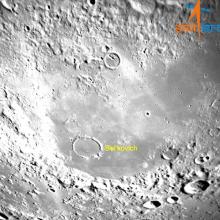Listen to today's episode of StarDate on the web the same day it airs in high-quality streaming audio without any extra ads or announcements. Choose a $8 one-month pass, or listen every day for a year for just $30.
You are here
Moon and Mars
Mars and the Moon are both quite dry. But they do contain sources of water. And some recent studies have found evidence of even more water.
Scientists studied volcanic deposits on the lunar surface that contain tiny glass beads. Similar beads were brought to Earth by Apollo astronauts. Analysis showed that the beads contained high concentrations of water.
And using observations made by a satellite from India, the researchers found evidence of water in volcanic deposits scattered across the Moon. The materials probably came from the Moon’s mantle — the layer below its crust. That suggests that the mantle could hold a lot of water.
Other researchers recently found evidence for more water on Mars in observations made a decade ago. The scientists developed a technique that improved the quality of those observations. The new analysis revealed a lot of hydrogen wafting above large areas around the equator. The hydrogen could be an indication that large amounts of water ice are buried beneath the surface.
Ice had already been found beneath the surface at high latitudes. But water at the equator wasn’t expected. The scientists still have a lot of work to do, though, to confirm the new analysis.
Mars and the Moon are part of a beautiful quartet in tomorrow’s pre-dawn sky. Mars stands close below the Moon, with the star Spica to the right of the Moon. The brilliant planet Jupiter perches to the lower left. More about this lineup tomorrow.
Script by Damond Benningfield





